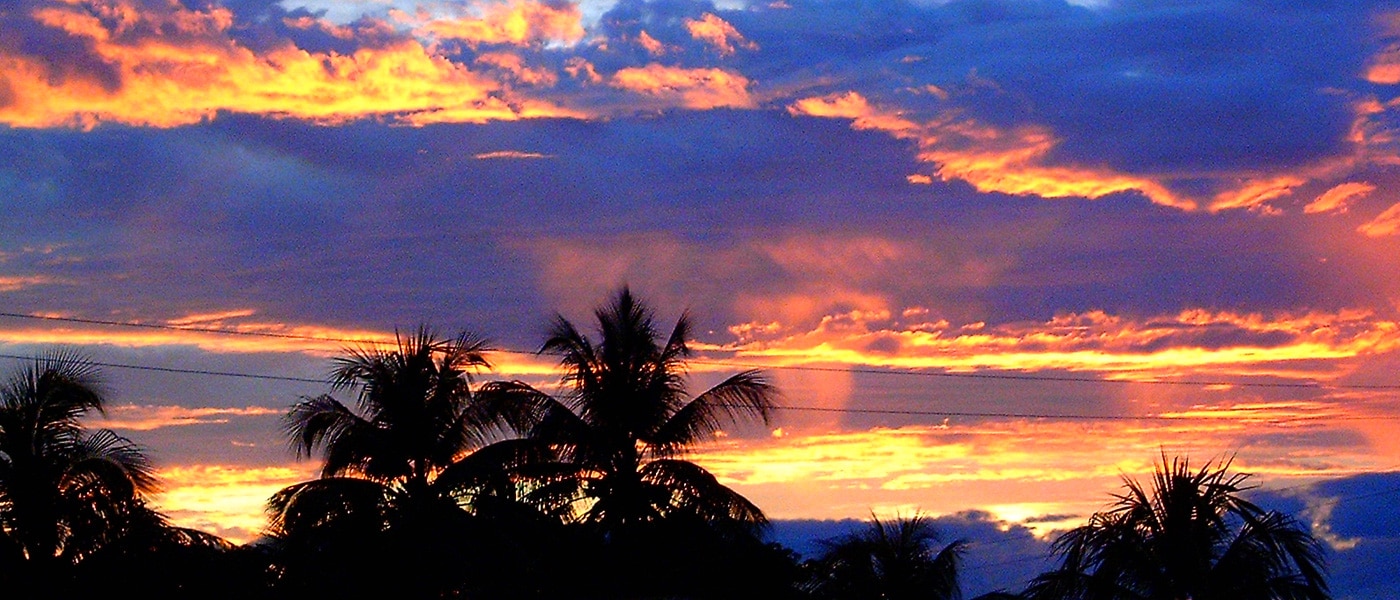Mesmerized by the thousands of warm bubbles surrounding me as if I were sitting in a giant glass of champagne, I settle slowly into one of several underwater hot tubs—heated geothermal springs created by volcanic gases released from the sea floor. I snorkeled here at Dominica’s Champagne Reef on a day excursion from a cruise ship a few years ago and had hoped to return, as it’s rated one of the Caribbean’s top snorkeling and diving sites. Finally, I was back, and this time with my husband. Along with our guide, we move on to explore the surrounding reef. Swimming through this lively watercolored world, we pass barrel and tube sponges of various sizes while sea anemones sway alongside familiar Caribbean fish – butterfly fish, parrotfish, and schools of blue tang. A porcupine fish, its spines flat against its body, retreats into a coral crevice.
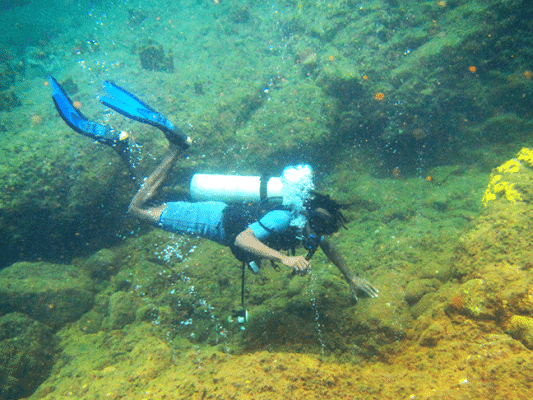
Our first dive of the morning involved a short surface swim before we descended to a small wreck where we encountered a large Hawksbill turtle. We hovered around it long enough to count the barnacles that had formed upon its shell, and then continued our survey of the coral-encrusted metal that had now become a living artificial reef.
Emerging from our second shore dive at Champagne Reef as awkwardly as we’d entered, we scooted ourselves onto the rocky beach, donned our Tevas, necessary for the tender footed, and made our way back to the dive shop to shower and change before heading for lunch at Papillote Wilderness Retreat.
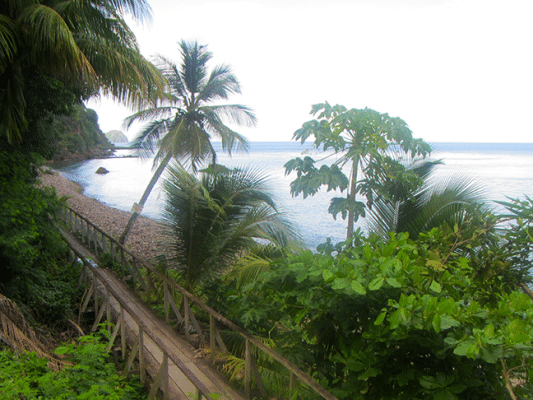
Dominica (pronounced Domineek-ah) is called the Nature Island of the Caribbean for a reason. With 365 rivers, one for each day of the year, and many waterfalls, visitors to this volcanic isle are never far away from water. Random rain showers are frequent and necessary to keep the flora and foliage lush, so our rainy arrival at Papillote Wilderness Retreat’s Rainforest Restaurant was nothing more than a needed dose of liquid sunshine.
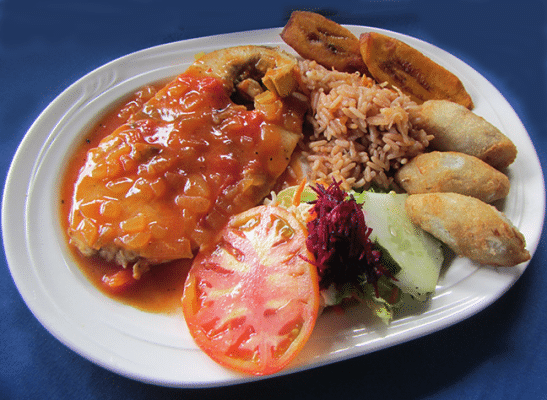
While we savored fish prepared Creole style and served with rice and plantains, a light rain continued to fall on the tropical gardens near the terraced dining area. The sun emerged in time for a guided stroll through the gardens’ many micro-habitats which included indigenous orchids, bromeliads, heliconias, and several less common types of ginger, including one I’d never seen before, a honeycomb ginger plant. Guests desiring a tranquil location for their island stay may book rooms overlooking the gardens, with access to four volcanic hot mineral pools and two waterfalls within Papillote’s 10 acres.
Just a few minutes walk from Papillote Wilderness Center is Trafalgar Falls, the most-visited of Dominica’s waterfalls. The twin falls can be viewed and photographed from a viewing platform, while the more adventurous can arrange to hike to the base for a swim.
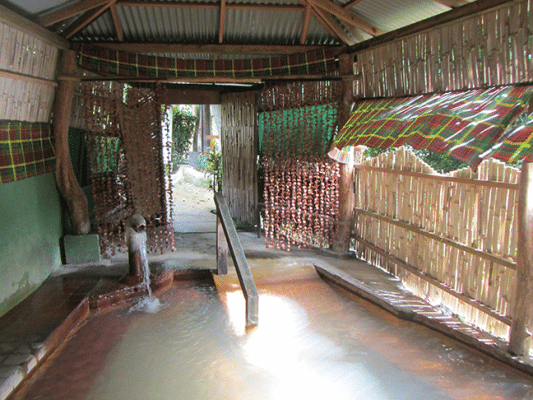
Our last stop before heading back to our resort was Tia’s Sulphur Spa in Wotton Waven, an area situated near the top of one of Dominica’s eight active volcanoes. While the island’s Office of Disaster Management says Dominica has one of the highest concentrations of potentially active volcanoes in the world, rest easy; the last eruption was about 500 years ago. After a relaxing soak in one of the enclosed hot pools, we checked out four large open pools down a flight of wooden stairs where volcanic mud wraps or massages can be arranged.
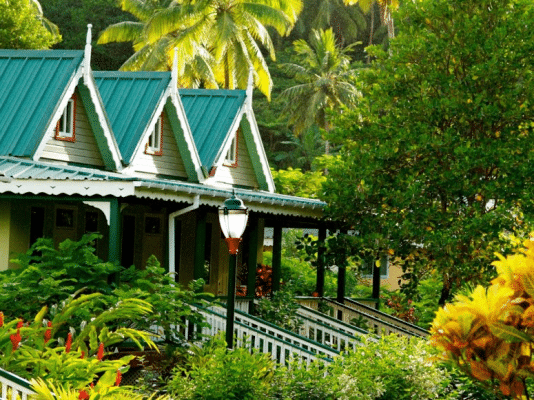
Our late arrival the night before had left us little time to orient ourselves to Rosalie Bay Resort, our temporary home while on Dominica. We’d arrived in time to down a late dinner and collapse into bed, then left after breakfast for a full day of exploring the western side of the island on the Caribbean Sea, where the majority of hotels are located.
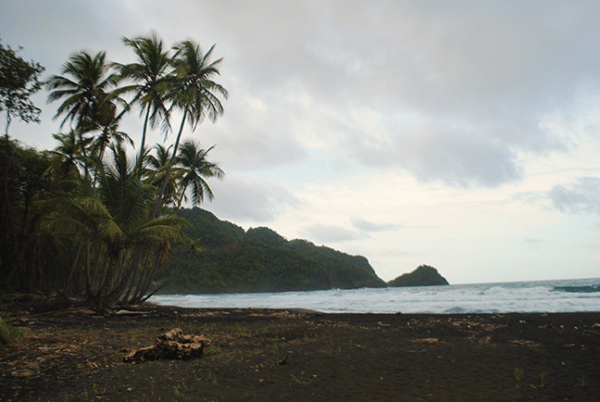
Rosalie Bay is about an hour’s drive away on the east coast, facing the Atlantic Ocean and intersecting with the Rosalie River at the point it empties into the sea. While guests don’t come here for water activities, due to the rough surf, a saltwater pool is available for swimming. What they do come here for can be summed up in two words—turtles and tranquility. The setting is dramatic, evocative of the South Pacific, with coconut palms reaching to the sky along the black sand beachfront. Twenty-eight rooms and suites are housed in gingerbread trimmed cottages with private verandas and furnished with hand-carved furniture made by local artisans. Ours faced the sea; others offer garden or riverside views.
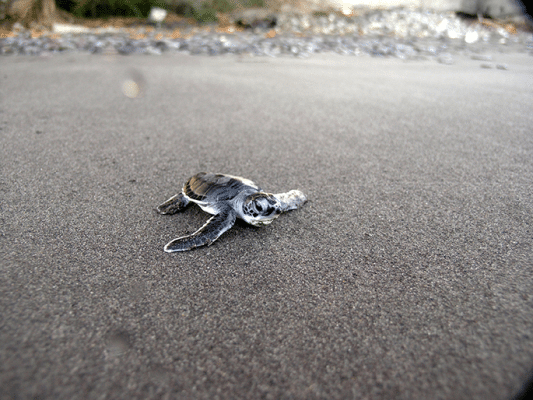
Besides the dedication of Rosalie Bay’s owner, Beverly Deikel, and her partner, Oscar, to make the resort a place of wellness and as eco-friendly as possible, they are strongly committed to protecting the sea turtles—leatherback, green, and hawksbill—who have been coming to Rosalie’s beach for years to lay their eggs. The 22 acre property was purchased in 2002 and opened in 2010 after eight years of planning, design and construction. Guests are invited to share in this marvelous mission through participation in nightly turtle tours. They can sign up, as we did, to be called if a turtle has been sighted on the beach or if hatchlings are ready to be released to find their way to the sea. While turtle season on Dominica starts in March and ends in September, the highest concentration of turtle nesting is in May and the best possibility of seeing hatchlings is in July, since the incubation period is around 70 days.
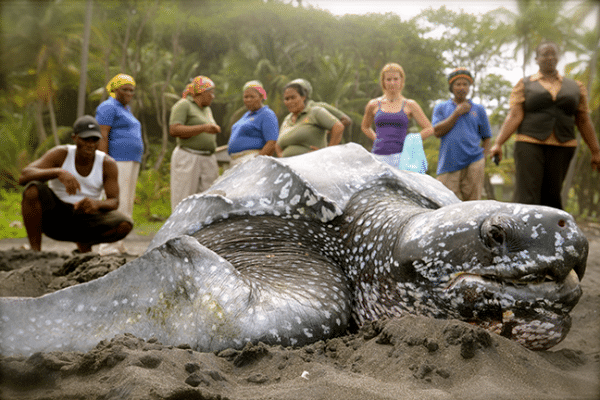
Resort offerings geared toward promotion of health and wellness include yoga on the beach, power walks through the rainforest, and a well-equipped fitness facility, located across from the new riverfront Gló Spa, set to open soon. It will replace the smaller oceanfront spa, where we treated our sore muscles to a massage on our last afternoon, before an early morning departure.
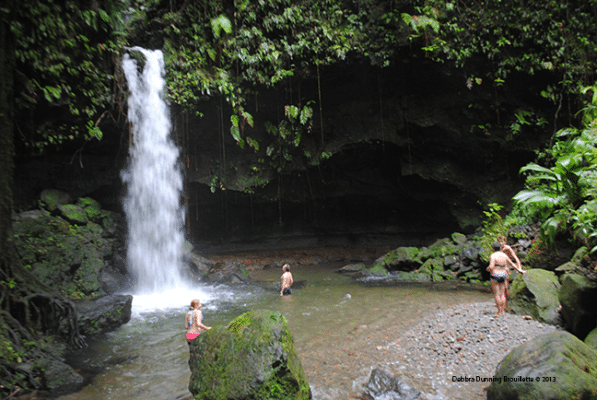
Very near the resort is Emerald Pool, a part of the Morne Trois Pitons National Park. An easy 15-minute hike on a trail through the rainforest leads to a waterfall and pool below, its waters bright green, reflecting the trees in the forest. When we arrived, there was just one other family enjoying a dip in the crystal clear waters.
No matter where you end up staying on Dominica, a visit to the Kalinago Territory on the northeastern coast is a must-do. Although Carib Indians were once found on most Caribbean islands, Dominica is the only one that still has a territory set aside for them.
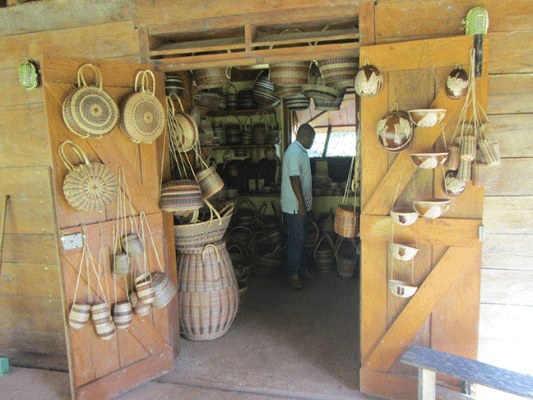
Over 3,700 acres of communal land are inhabited by approximately 3,000 of the island’s indigenous people, who call themselves Kalinago instead of Carib, a name later given to them by Europeans. The Kalinago territory is unique in the Caribbean and includes the Kalinago Barana Aute and the Touna Kalinago Heritage Village, where visitors can learn about their history, along with their crafts and traditions. Our female Kalinago guide led us through the Barana Aute model village, which is literally translated “cultural village by the sea.” We watched demonstrations of cassava bread baking, basket weaving using reeds from the larouma plant and learned how canoes are carved from tree trunks. Baskets, pottery and items made from the calabash gourd are available for sale and make unique souvenirs and gifts for friends and family back home.
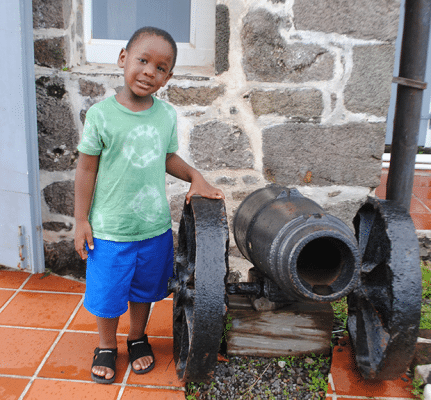
We returned to the west side of the island another day to tour Fort Shirley, a British garrison for 600 soldiers dating back to the 18th century. Several cannons remain, overlooking Prince Rupert Bay. A young visitor, part of a group on a school field trip, posed for me next to one of the small cannons at the entrance to the fort’s main building. The fort is located near Portsmouth, Dominica’s second largest town, where Ross University School of Medicine has been based since 1978. After lunch at Uptown Diner, across from the medical school, we drove to a nearby dock where we boarded a rowboat for a guided Indian River tour, a popular excursion for cruise ship passengers. We glided deep into the mangrove-lined wetlands, sighting herons, egrets, and large ghost crabs along the way. Our guide regaled us with stories about Johnny Depp and crew, who were here several years ago shooting parts of Pirates of the Caribbean 2 and 3.
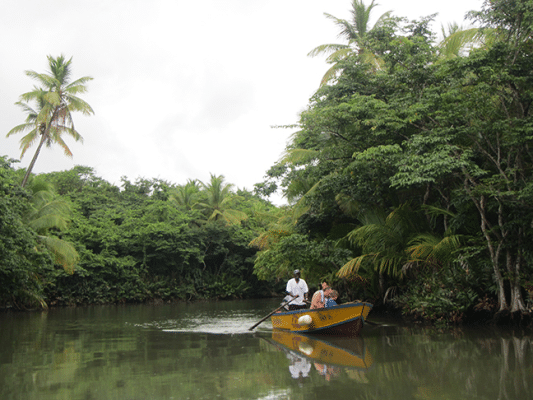
Just as I vowed to return to Dominica after my visit a few years ago, I’m putting it back on my list. There is still much more to experience on this beautiful, untouched island, and in the waters surrounding it. Next time I’ll go whale watching, explore more of its pristine reefs, and, maybe, just maybe I’ll witness newborn turtle hatchlings making their way to the sea on Rosalie Beach.
[alert type=white]
Note from the Author:
Where is Dominica?
Located between the French Caribbean islands of Martinique and Guadeloupe in the Lesser Antilles, Dominica is often confused with the Dominican Republic, which shares the island of Hispaniola with Haiti. Dominica is still an under-the-radar island that has not yet been substantially changed by the 359,000 visitors who arrived by plane, cruise ship or yacht in 2012 to sample its natural wonders. Nearly 79,000 of those were stay-overs, while cruise ships and yachters accounted for the rest. Around 19,000 visitors were from the U.S. and the majority from surrounding islands in the French West Indies.
Tourist Information – Discover Dominica
The international dialing code for Dominica is 767.
[/alert]
[alert type=white]
Where to Sleep:
Rosalie Bay Resort
Rosalie, Dominica
US Toll Free: (877) 732-2864
US Direct: (954) 453-5040
Local Direct: (767) 446-1010
Papillote Wilderness Retreat
P. O. Box 2287
Roseau Valley, Dominica
US Direct: (767) 448-2287
The Anchorage Hotel
P.O. Box 34, Castle Comfort
Roseau, Dominica
US Toll Free: (888) 790-5264
Local Direct: (767) 448-2638/9
Fort Young Hotel
Victoria Street, P.O Box 519
Roseau, Dominica
US Toll-free: (855) 223-9519
Local Direct: (767) 448-5000
Secret Bay
Portsmouth, Dominica
Local Direct: (767) 445-4444
Where to Eat:
Zamaan
Rosalie Bay Resort
Rosalie, Dominica
US Toll Free: (877) 732-2864
US Direct: (954) 453-5040
Local Direct: (767) 446-1010
Waterfront Restaurant
Fort Young Hotel
Victoria Street, P.O Box 519
Roseau, Dominica
US Toll-free: (855) 223-9519
Local Direct: (767) 448-5000
Pagua Bay Bar and Restaurant
Pagua Bay House
Marigot, Pagua Bay, Dominica
(767) 445-8888
Papillote Rainforest Restaurant
P. O. Box 2287
Roseau Valley, Dominica
US Direct: (767) 448-2287
Uptown Diner
Picard Highway (next to Ross University)
Portsmouth, Dominica
Local Direct: (767) 445-6954
What to See and Do:
Hike to Boiling Lake—Dominica is a fabulous destination for hikers of all levels. Advanced hikers should plan an all-day hike to and from Boiling Lake with a local guide. It’s the island’s most strenuous trek, taking hikers through the Valley of Desolation to arrive at the world’s second largest boiling lake. Boiling Lake is part of the Morne Trois Pitons National Park, a UNESCO World Heritage Centre, which is centered on the 4,402-foot volcano of the same name.
Go Whale-Watching—The only place in the world where sperm whales reside year-round are the waters surrounding Dominica. Between November and March, sightings of the world’s largest toothed animal and deepest diving mammal are most common, but boat operators claim success rates of 80% or higher any time of year. Whale watching tours often occasionally include surprise visits from pilot, humpback and false killer whales. Pods of dolphins often make an appearance, too.
Go for Dive Fest in July—Scuba divers may wish to plan a visit during Dive Fest, held annually July 4th-15th. Dominica’s reefs are colorful, healthy and uncrowded. Since all dive sites are located in the calm waters of the Caribbean Sea, look for accommodations on the western side of the island.
Go for the other Festivals— Carnival 2014 is March 3rd & 4th, 2014, while the two weeks prior to Dominica’s Independence Day, November 3rd, are filled with special events, including Creole in the Park, the World Creole Music Festival, Creole Day and the Cultural Gala.
[/alert]

